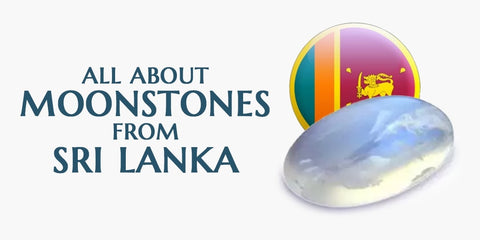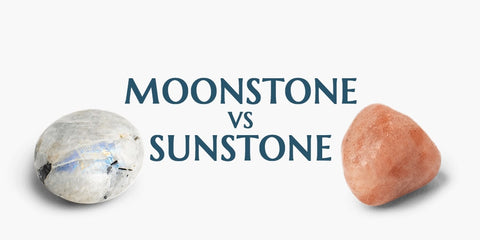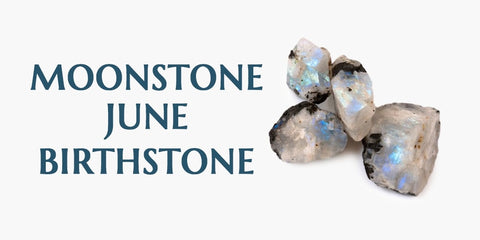
What is a moonstone ?
The moonstone is related to women, tides and the unconscious. It is a mysterious stone, associated with the moon. In Eastern Europe, it has long been used as a good luck charm. In crystal healing, it is used to accompany those who use it on an inner journey to discover their own hidden truths. It helps to find the part of oneself that has been lost, often the truest part. It brings light where (in the inner world) darkness has fallen. But what is the moonstone? We will see in detail everything there is to know about this gemstone.
The evolution of the moonstone
Moonstone received its name in the late 18th century. Its name is due to its appearance, as its shimmer, also called adularescence, is reminiscent of moonlight. It is because of this reflection that it also bears the synonymous name of adularia. Moonstone has always impressed people with its mysterious and soothing radiance. Already in ancient Greece, among the Arabs or the Romans, this gemstone was considered a symbol of the power of the moon. It has always been mentioned as a source of energy for women. The designation of medicinal stone was also common for these gems many, many years ago. In ancient times it was also known as selenite or mary glass.
The color of moonstone

The color of moonstone varies from colorless, white, yellow (sometimes called noble orthoclase), peach, pink, gray and, in rare cases, green and brown. The common characteristic of all moonstones is the bluish-white, slightly silvery sheen on the surface of the stone - a consequence of the lamellar structure in the mineral which, when exposed to light, manifests itself by refraction and scattering of light in the form of a bluish-white sheen (called adularescence). Despite the diversity of colors, the color of the moonstone line is always white.
Places of discovery and moonstone deposits

Moonstone is formed mainly in rock caves and also consists of aluminum, silicon, potassium and oxygen. The brilliance of moonstone is due to the fact that the embedded albite layers appear bluish white when light is refracted and scattered by the effect of light. Moonstones are found in many countries. It is mainly the location where they are found that determines their color or brilliance. Blue moonstones are considered to be of very high quality and come mainly from Madagascar, while stones from India have a more cloudy shade, even orange. The largest moonstone deposits are found in Sri Lanka today. Other places of discovery and important deposits are for example:
- Australia: Northern Territory, Queensland
- Myanmar: Mogok
- Austria: Spitz, Tyrol, Lower and Upper Austria
- Tanzania
- United States: Cambria, Cleveland, Coosa County, Danbury, Connecticut, Moonstone Beach, North Carolina
- Norway: Larvik, Iveland
- Poland: Lower Silesia
The symbolism of the moonstone

Moonstone is considered a feminine gemstone. It particularly helps to promote femininity and contributes to its development. Moonstone is a whitish, yellowish to grayish and light brown gemstone, which can also be light blue. It shines beautifully all over its surface when moved. It is a monoclinic gemstone. It is rarely triclinic and does not form crystals. It is therefore presented in the form of massive or granular aggregates. It crystallizes in the monoclinic crystal system, the crystals being prismatic, columnar or spatial. Moonstones can also be twinned. As a variety of orthoclave, it belongs to the feldspar group. Moonstone has a hardness of 6 to 6.5 on the Mohs scale and has an irregular to conchoidal fracture. The color of the line is white. Its transparency ranges from clear to translucent. Today, moonstone is one of the most sought-after gemstones and medicinal stones. It can be found as a drum, amulet, pendant, ball or ring, or of course on a matching necklace.
Although moonstones differ in transparency and color depending on where they are found and there are many variations, all moonstones have one thing in common: they are mystical and mysterious. In India, the moonstone is considered a dream stone that allows for sweet dreams. Arabia and its neighboring countries see the moonstone as the "stone of women". In order for women to wear it close to their bodies, they often sew moonstones into their clothes.
If it is called the stone of lovers, it is because it is attributed a power that arouses tenderness and strengthens one's own intuition. In ancient Rome and Greece, the moonstone was already considered an important gemstone, which was and is still attributed with extensive healing and action powers. The Greeks and Romans considered it a stone of strength capable of amplifying the properties of the moon on earth. That is why they venerated it not only as a stone of magical protection, but also as a stone of healing.
The benefits of moonstone on the body and mind

Moonstones have positive effects on the body, mind and soul. The "women's stone" has a particularly pronounced effect on the female sexual organs. It helps to regulate the hormonal balance. It thus supports fertility. It also helps to fight against menstrual disorders. The positive effect of moonstone on fertility and pregnancy has long been an important strength. It has a positive influence on the pregnancy itself and on the period that follows. The regression after pregnancy goes better, milk production is regulated and later, during the menopause, it is a much appreciated companion. In addition, this gemstone brings serenity, vitality and balance to women. Its youthful radiance is enhanced.
Overall, moonstone has a positive effect on the entire glandular system and stimulates the metabolism. The effect of moonstone or the perception of its healing power is enhanced by the potassium content and the skeleton silicate. The potassium in moonstone supports above all the ability to tune into the universal rhythmic laws. The psychic effect ranges from addiction to the moon to strengthening intuition and feelings. Thus, moonstone helps in cases of lack of self-confidence and strong mood swings.
It also contributes to the memorization of dreams and helps in the formation of dreams. On the one hand, it is a good companion for people who are close to water, on the other hand, it allows to better let your emotions flow and to cry. Its harmonizing and balancing effect on the psyche is appreciated by many people, not only by women.
Moonstone as an ornamental stone

Today, moonstone is used exclusively as an ornamental stone. If it is cut with a cabochon, its lamellar structure brings out its brilliance. Thus, it can happen that it presents a "cat's eye" effect when it is illuminated by a well-defined band of light, which is called chatoyage. Moonstone is considered to be very sensitive to pressure, which is due to its low hardness and perfect cleavability. Genuine moonstone that can be used for jewelry is very rare. White labradorite is often used to imitate moonstone.
Currently, this gemstone exists in different colors and under different names. The blue or Californian moonstone has a bluish luster, the rainbow moonstone is a white labradorite with blue highlights and the black moonstone is just an outdated name for labradorite. Its brilliance and beauty are very well enhanced by a silver ring. The carat weight of moonstone as jewelry is the basis for determining its price. The place of discovery, color, size and luster, cut, purity, shape and treatment are also taken into account. The weight of the precious metal is less important.
Zodiac signs and moonstone
Moonstone is associated with the zodiac signs of Cancer, Pisces and Aquarius. It is the main stone of Cancer, to whom it opens the eyes to reality and gives the necessary discernment. With this stone, Pisces becomes more receptive to the outside world and Aquarius experiences a connection with nature and a better ability to relate to others. Moonstone is also associated with the astrological signs of Libra and Scorpio. It is considered the symbolic stone of the moon, Venus and Neptune. As the stone of the month, it belongs to the month of June and as a decan stone, it is assigned to the third decan.
Warning: Gemstone medicine should only be used as a supportive healing measure. In case of persistent pain or unclear disorders, a doctor should be consulted urgently.
Proper use and care of moonstone

In order for the moonstone to unfold its effects in an optimal way, there are different ways to use it depending on the area of application. In order to feel its energy, it should be worn for a long period of time, ideally directly on the body. Women also have the possibility to make their menstruation coincide with the lunar phases. Another possibility is to place the gemstone on the heart and forehead. In case of moon addiction, it is recommended to place the moonstone under the pillow during a lunar phase from the new moon.
It is also possible to prepare a gemstone water and use this essence. For an optimal healing effect of the gemstone, the use should be regular. When used, the soft and powerful vibrations of the moonstone penetrate deeply into the sensitive and receptive parts of the soul. Like any gemstone, moonstone loses its positive energy over time. That is why it is important to clean it after each use under warm running water. To discharge it, it is placed once a month in a dry bowl containing hematite drum stones. Women should discharge the moonstone after menstruation. The stone is recharged during the night under the moon. It thus receives the energy force of the moon. The full moon is the most appropriate time, but all other lunar phases also work.






